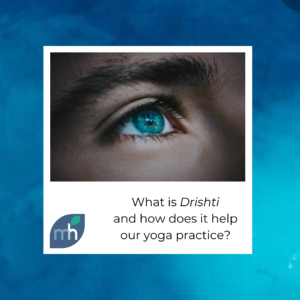Drishti is a yogic gazing technique that develops concentration and relaxation but allows an inner focus which helps quieten the mind. It is a practice of mindfulness and I liken these moments of focus to mini meditations.
Humans are visual creatures and even when practising yoga, or in everyday life, it is easy to be distracted – where are eyes are directed our attention will follow. Today’s world can be visually addictive and overstimulating – and it is ‘on’ 24 hours a day. No wonder so many experience high levels of stress. As our awareness flows out of us distracted by external influences, so does our prana (vitality). When we control and direct the focus of our eyes this is then followed by our attention. This is the yogic technique called drishti.
In Hatha Yoga (physical yoga) on a simple level, each asana or posture has a drishti point. They assist concentration, aid movement and bring awareness to how we are ‘resting’ in the posture as well as allowing orientation of the energetic body. In total there are 9 and each different point can be a useful anatomical tool. For instance when we gaze at:
- Finger tips (warrior poses) or a far point (twists) – it keeps our line of concentration strong and connected to the outside world,
- The navel (Downward Dog) – we turn our focus inwards finding a strong and still centre,
- Big toes (Seated Forward Bend) – helps focus on the alignment of the spine and neck,
- The hand (Triangle Pose) – draws our energy upwards and opens the heart (Hastagrai Drishti), and
- The third eye with closed eyes (Meditation) – soothes the mind and strengthens our spiritual self (Antara Drishti).
However if we find that closing our eyes during practice brings up dramas or concerns we are better finding an external vision and vice versa.
The practice of Drishti is not limited to its value in asana. In Sanskrit, drishti can also mean a vision, point of view or wisdom. Our eyes focus on what they can see when the eyes are open. However when we close our eyes, the practice of Drishti can help us practice detachment as our attention is drawn inwardly away from external perplexities of life. It allows our mind and thoughts to soften, reduces mind chatter, anxiety, it allows our breath to deepen and helps us create a deeper sense of peace.
What we gaze at during yoga and outside of yoga can have an affect on the how the body feels. If you feel stressed and gaze at trees or flowers, there is a softening in the body. On the other hand the body becomes tense when looking at something hard or cold. The practice of drishti gives us a tool to remove distractions and therefore notice the wanderings of our attention. It helps us balance the mind and the body.
Value your time in yoga to find these mini ‘breaks’ and, next time you find yourself in a day dream in everyday life understand its value to your mental and emotional health.

